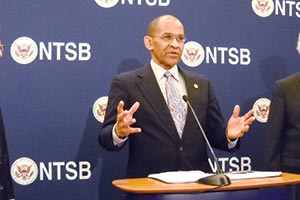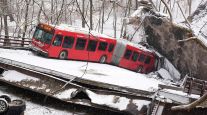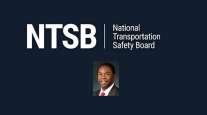NTSB Adds Truck Safety to List of Top Priorities

This story appears in the Jan. 19 print edition of Transport Topics.
WASHINGTON — Stronger commercial truck safety is one of the new issues on the Most Wanted List of policies and actions issued by the National Transportation Safety Board.
It is an annual list of the top 10 areas that need safety improvements.
“The Most Wanted List is our road map for 2015,” said NTSB acting Chairman Christopher Hart. “We want it to be a road map for policymakers and legislators as well. These are safety improvements for which the time is ripe for action.”
Hart and two other NTSB members unveiled the list during a press conference here Jan. 13, coinciding with the annual meeting of the Transportation Research Board.
The new areas of focus are: requiring commercial transportation operators to be medically fit for duty; increasing safe movement of rail tank cars that carry crude oil, ethanol and other hazardous materials; and implementing positive train control by the end of this year.
“At the NTSB, we want to make new strides in transportation safety in 2015, and we want to lay the groundwork for years that are even safer,” Hart said.
NTSB does not regulate any industries. Rather, its staff investigates transportation accidents and makes recommendations to regulators and Congress on how to improve transportation safety.
The main safety regulators for trucking are the Federal Motor Carrier Safety Administration and the National Highway Traffic Safety Administration.
Still, Hart said, truck safety should be approached as a “broad spectrum” of policies, including vehicle maintenance, driver fitness and deploying new safety technology in trucks.
FMCSA spokesman Duane DeBruyne said truck and bus safety remains the agency’s top priority.
“While there’s been a significant decline in heavy-truck crashes over the past decade, there are still far too many families who’ve lost children, spouses or other loved ones in truck crashes,” DeBruyne said.
“We continue to use all the tools at our disposal, including the deployment of new technologies, to ensure that drivers are well-rested and alert behind the wheel, and to shut down those high-risk companies with troubling safety records that fail to fix their problems,” he added.
Some high-profile accidents, including one involving a Wal-Mart Stores truck that hit the luxury van of comedian Tracy Morgan in June, have led to greater scrutiny of the trucking industry.
But a swell in technology for avoiding collisions or mitigating the results, recording driver hours of service and monitoring other regulations signals an industry poised to change.
American Trucking Associations spokesman Sean McNally said several items on NTSB’s list align closely with ATA’s policies and progressive agenda for improving highway safety.
“ATA has called for tougher impaired driving and distracted driving laws for all motorists,” he said.
Distraction and impairment remain key issues on the NTSB list. It said that, according to the National Highway Traffic Safety Administration, in 2012, about one in 10 drivers in fatal crashes were distracted, and in almost a third of fatal crashes, a driver was impaired by alcohol.
“We appreciate NTSB’s acknowledgment that successful efforts to further improve truck safety must be collaborative. We look forward to working with NTSB to this end. Also, we hope the board will be committed to a data-driven focus on the most common causes of truck crashes,” McNally said.
The Commercial Vehicle Safety Alliance, which represents truck and bus safety inspectors working for North American law enforcement, recommended more seat-belt usage and increased funding for safety inspection programs.
“Seat belts are not sexy. They’re simple, but they work,” said Stephen Keppler, CVSA executive director, adding that, every year, officers find unbelted occupants ejected from truck cabs due to accidents.
He also said federal funding for inspections “has been flatlined for the past five or six years, even though the truck and bus industries have been growing.”
Positive train control is another NTSB issue. It has been mandated by Congress, and Hart said he wants to make sure railroads stick to it.
It is a system that monitors and controls freight and passenger train movements by taking over when a train engineer fails to act.
NTSB also said it is focusing on all modes of mass transit for greater operational safety — a statement that came a day after it began investigating an accident here involving a local Metro train that abruptly stopped in a tunnel and filled with smoke, killing one passenger.
Hart, who has been nominated by President Obama to become the board’s permanent chairman, will be the board member in charge of the truck safety segment. He said each of the 10 items on the list will be directed by a specific board member.




